Posts for Tag: society
ADHD is a disorder, not a disease
Voodoo & Vatican
The similarities between voodoo and Roman Catholicism are remarkable. After the Spanish killed all the New World natives on the island of Hispaniola, they imported slaves by the hundreds of thousands from West Africa.
Only in the New World did Roman Catholicism and African paganism merge to create the symbiosis called voodoo. Originally, all the false gods of Africa came from Egypt via Ethiopia. Before the Exodus in 1533 BC, Egyptian gods were worshipped all over Africa and as far east as India.
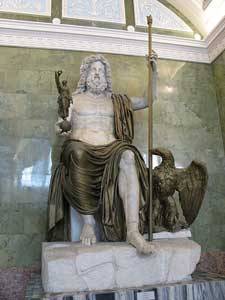
Zeus is the voodoo counterpart to Blondye.
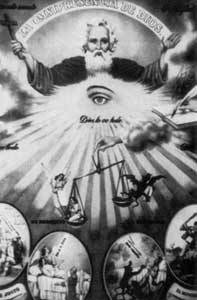
Bondye is the head of the voodoo pantheon.
In the voodoo pantheon, Bondye is considered the creator of the universe. Bondye comes from the French bon (good) and dieu (God). Zeus is his counterpart in Greece, and Jupiter in Rome. Unlike Zeus, he is holding a cross as his symbol of authority.
Voodoo has an exact equivalent to the Latin Church Saint Peter. He is called Papa Legba and he is associated with the keys of the underworld.
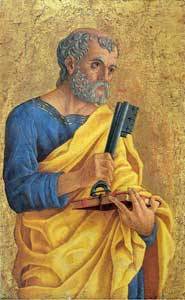
Papa Legba is based on the Papal Saint Peter.
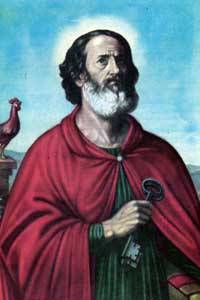
Voodoo god Papa Legba a.k.a. Saint Peter.
The voodoo god Papa Legba has the keys of the gates of hell. The Papal Saint Peter, with the keys, is his counterpart in the Latin Church. Roosters are sacrificed to Papa Legba because Saint Peter denied the Messiah 3 times before the rooster crowed! (Matthew 26:69-74).
In the Latin Church, Saint Peter is associated with opening and shutting the gates of heaven and hell. Because St. Peter denied the Messiah 3 times before the rooster crowed, Papa Legba is appeased by the sacrifice of a rooster.
Damballah is the supreme Allada serpent divinity, associated with rain, wisdom, and fertility. He is usually depicted entwined with his wife Ayida Wèdo, the rainbow spirit.
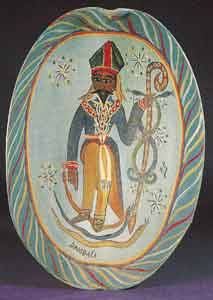
Damballah is the voodoo serpent god.
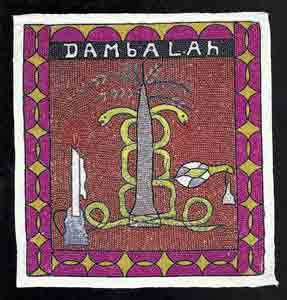
Voodoo Damballah flag.
Damballah is the supreme Allada serpent divinity, associated with rain, wisdom, and fertility. He is usually depicted entwined with his wife Ayida Wèdo, the rainbow spirit.
Damballah is often represented as Saint Patrick… and Moses… Satan always looks for similarities between his religion and Christianity in order to corrupt the Gospel of Christ.
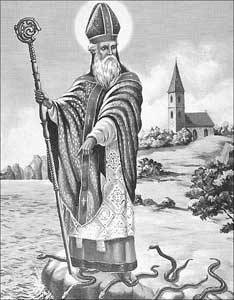
Damballah is worshipped as Saint Patrick.
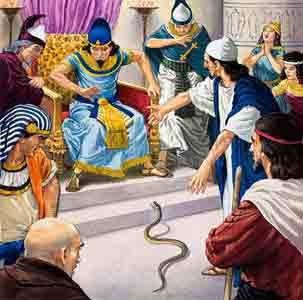
Damballah is worshipped as Moses.
Damballah is worshipped as Saint Patrick and Moses! Saint Patrick drove the snakes out of Ireland, and Moses changed a rod into a serpent in the court of Pharaoh. Driving out the snakes symbolizes Saint Patrick’s great success in converting Ireland from Druid paganism to the Gospel of Christ.
The real Saint Patrick did drive the snakes out of Ireland when he converted that country from paganism to true Christianity.
The Papal “bishop” Patrick is pure myth and legend because the real Saint Patrick had no connection with Rome; and the position of bishop does not exist in the Christian congregation… Saint Patrick was an Episcopus… and not a bishop.
The snakes he drove out of Ireland were the two-legged ones called druids who practiced diabolical human sacrifice and cannibalism.
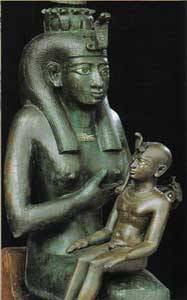
The Egyptian Isis is the model for Ezili Danto.
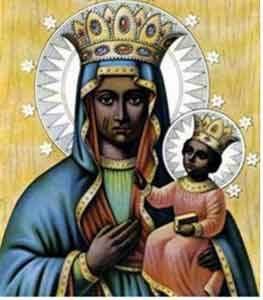
Mater Salvatoris or Ezili Danto.
Ezili Danto was originally copied from the Egyptian Isis. This “virgin” is the Greek equivalent to Helena and the Roman equivalent to Minerva. In French she is called Marie and Mary in English.
Santiago and Saint George correspond to the African war loa Ogun.
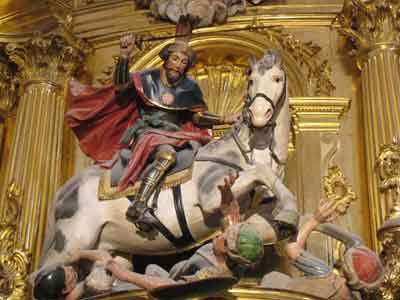
Santiago trampling a Muslim Moor with his warhorse.
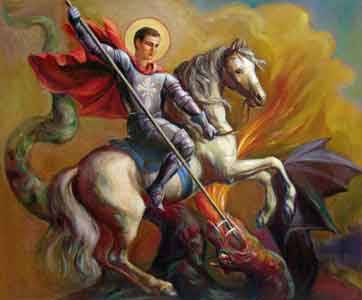
Saint George slaying the dragon.
The voodoo war god Ogun corresponds to Santiago and Saint George. Santiago is the patron “saint” of Spain and Saint George is the patron “saint” of England!
Bizarre rituals are held to consecrate voodoo clergy. A voodoo priest is called a houngan and a priestess is called a mambo.
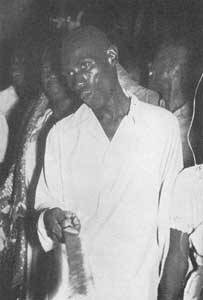
A voodoo houngan or priest presiding over the mystères.
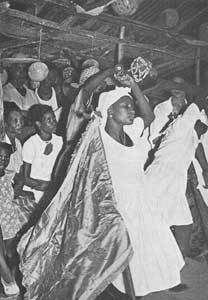
A voodoo mambo or priestess presiding over the mystères.
A voodoo priest who presides over themystères is called a houngan or papa-loa. A voodoo priestess is called a mambo ormaman-loa. A voodoo priestess is called a mambo ormaman-loa. The Vatican’s priests and nuns are their counterparts.
The major difference between Latin and voodoo clergy is that marriage is not forbidden to voodoo clergy, and voodoo has nothing comparable to the Latin Church’s auricular confession. However, they do have to appease the offended loa by doing penance:
In order to obtain forgiveness from an offended loa Voodooists also practise various forms of external, typically mediaeval, Catholic penitence. The penitents, usually women, wear garments made of grey, so-called ‘siamese’, cloth or a kind of harlequin dress made of bits and pieces which correspond in colour to the various different loa; the clothes must be blessed by the bush-priest. Having sung a Mass, burnt some candles and said prayers to the saints, the penitents offer their friends and relations a grand farewell feast. Then they go out, all over the countryside, visiting in turn all the main places of pilgrimage–Saut-d'eau, Vierge du Mont Carmel, Alta Grecia, Saint Dominique–and live on public charity and on the food distributions which certain pious people dole out to acquit themselves of debts to loa or saints. They frequent the markets where they are sure to get a few sous and at least some fruit and vegetables. When they think that by their suffering and weariness they have expiated their sin in the eyes of their protecting loa they go home and resume their normal life.“(Métraux, Voodoo in Haiti, p. 333).
This is almost an exact description of the career of Saint Martin Luther when he decided to save his soul by becoming an Augustinian monk!!
Almost the entire Vatican pantheon is represented in voodoo. Lenglensou basen san is the counterpart to the Sacred Heart of Jesus or le Sacré-Coeur de Jésus. Basen san means basin of blood in Creole and that is the correlation between the Sacred Heart of Jesus and blood.
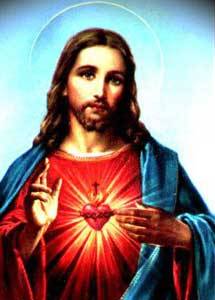
The voodoo Sacred Heart of Jesus.
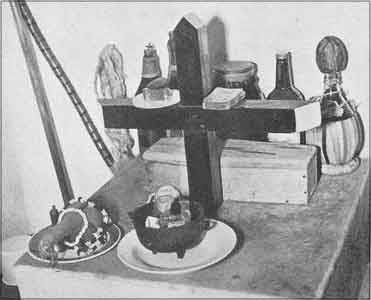
A voodoo altar consecrated to all the loa.
The voodoo god Lenglensou basen san is worshipped as the Sacred Heart of Jesus or le Sacré-Coeur de Jésus. In voodoo, loa or mystères inhabit pictures and statues used as visual aids in prayer or worship. A voodoo altar consecrated to all the loa with a deck of cards for divination resting on the cross.
Another diabolical practice of voodoo is human sacrifice and cannibalism, which was very common in Haiti until recent times. Since its suppression by more enlightened governments, it has just gone underground.
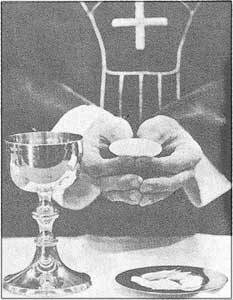
Literal flesh, under the appearance of bread, is eaten at the Latin mass.
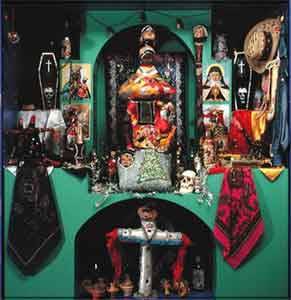
Voodoo altar prepared for the REAL PRESENCE of the loa.
Though recently suppressed, bloody human sacrifices and cannibalism is a vital part of the voodoo religion. The Latin Church mass, with its sacrifice of Christ, and eating of his literal flesh, is the counterpart to voodoo cannibalism. The Latin Church’s unbloody sacrifice is called transubstantiation, or the REAL PRESENCE, and it originated with the Latin Vulgate Version.
Cannibalism was a prominent feature of the Greek gods of antiquity. Cronus, the father of Zeus, ate 5 of his own children.
The Latin Church’s practice of eating a sacrificial victim under the appearance of unleavened bread or azymes originated with the Latin Vulgate Version. In the Sermon on the Mount, the Messiah told us to pray for our daily BREAD, but the Latin Vulgate says to pray for our SUPERSUBSTANTIAL bread:
Give us this day our daily bread. - Matthew 6:11
That quote is something like Zeus from Mount Olympus would say although his father Cronus tried to devour him as soon as he was born.
In 1563, the Jesuit dominated Council of Trent made belief in transubstantiation mandatory:
CANON I.-If any one denieth, that, in the sacrament of the most holy Eucharist, are contained truly, really, and substantially, the body and blood together with the soul and divinity of our Lord Jesus Christ, and consequently the whole Christ; but saith that He is only therein as in a sign, or in figure, or virtue; let him be anathema. (Canons and Decrees of the Council of Trent, Session 13, Canon I).
CANON lI.-If any one saith, that, in the sacred and holy sacrament of the Eucharist, the substance of the bread and wine remains conjointly with the body and blood of our Lord Jesus Christ, and denieth that wonderful and singular conversion of the whole substance of the bread into the Body, and of the whole substance of the wine into the Blood–the species Only of the bread and wine remaining–which conversion indeed the Catholic Church most aptly calls Transubstantiation; let him be anathema. (Canons and Decrees of the Council of Trent, Session 13, Canon II).
Here is a statement about the mass and demon possession by a French expert on voodoo:
Catholic communion is considered by certain Voodoo priests as a sacrament which increases their powers; sometimes they recommend it to their clients. Even further: some loa are regarded as Catholics and by virtue of this fact must communicate from time to time. This is notably the case with Damballah-wédo; when the god feels the need to approach the Holy Table, he tells one of his servants who then prepares himself, as a good Christian, to take the sacrament and when the day comes, putting a stone sacred to Damballah in his pocket, goes and kneels before the altar; at the very moment of taking communion he is possessed by Damballah who communicates in his place. A woman of Jacmel who was more or less a Voodooist told me that one Sunday during Mass she noticed signs of strange excitement in one of her neighbours. She watched her and realized that she had Damballah in her head. This woman went up to communicate and it was only at the moment when she got back to her place that she frankly abandoned herself to trance. While she was being removed from the church the loa inside her kept calling out: "They were saying I couldn’t communicate; well I have.”(Métraux, Voodoo in Haiti, p. 332).
The logical conclusion to the dogma of transubstantiation; and almost beyond belief, is that the Vatican has turned her devotees into Cannibals for Christ!!
The voodoo statement of “faith”
The most commonly held voodoo beliefs can be summarized by the following creed:
I believe in Bondye, the Almighty Father of the sky, who manifests his spiritual nature in me; in a large number of spirits; and in all things visible and invisible.
I believe in the lwas, the gods of Africa, and all the saints of the Catholic Church. Masters of the universe, they are manifestations of Bondye, who see all things and direct the course of all things; that some have made themselves known to us through our ancestors in Africa, and that others we have come to know, emulate, and serve in our new home in Haiti; that these lwas are potent enough to mount us, their children, in spirit possession; and that through their mounting, they can inspire us as to the needs of our community; that our moral duty is to faithfully serve them; that the lwas are capable, like us, of gentleness and mercy, but also of anger and revenge.
I believe in the power of ancestors who watch over us and serve us before the l was; that they must be remembered and served faithfully.
I believe in the right granted to us by the l was to interfere through magic in the normal flow of events as established by Bondye’s will; in the efficacy of the medicines derived from the local fauna endowed to us by the l was. I believe in the Holy Roman Catholic Church, in the communion of saints, and in life everlasting. (Desmangles, The Faces of the Gods, Vodou and Roman Catholicism in Haiti, p. 63).
No wonder Jehovah gave this final warning to his people: And I heard another voice from heaven, saying, Come out of her, my people, that ye be not partakers of her sins, and that ye receive not of her plagues. - Revelation 18:4
Written and edited by Patrick Scrivener
The World Beyond Belief 145 - the flat earth/globe earth deception
It might look like a new agey podcast but it is not.
The transhumanist agenda is about as in your face as it gets
Lemon and baking soda combination saves lives

The combination of lemon and baking soda has 10 000 times more stronger effect than chemotherapy!
Why was this fact kept as a secret?
Being totally aware of the powerful properties lemon provides is completely opposite to the interest some world organizations have. For that reason, we recommend you share this article and help a friend who needs it!
Do you have any idea of the recent number of deaths because this secret was jealously kept in order to protect large corporations?
Numerous studies have proven the anti-cancer properties of lemon. Lemon also provides other benefits, including its strong power in treating cyst and tumors.
Lemons have the power to cure cancer, since it has been tested on all cancer types. Adding baking soda makes it even more powerful, because baking soda brings pH to normal level.
Lemon also has potent antimicrobial effect in treating bacterial and fungal infections. It is effective in the fight against internal parasites and it regulates blood pressure. Lemon is beneficial for the nervous system as well – it is a powerful antidepressant, reducing stress and calming nerve crises.
One of the largest drug manufacturers claims that 20 laboratory experiments, conducted since 1970 until recently, proved that:
Lemon destroys cancer cells in 12 cancer types. It prevents metastasis of cancer cells and it is 10 000 stronger than drugs like Adriamycin, chemotherapy and narcotic products.
What is more interesting is the fact that the combination of lemon extract and baking soda destroys cancer cells only, without harming healthy cells and tissues.
The experiments have shown that patients diagnosed with cancer should drink lemon juice and a teaspoon of baking soda. This treatment can not cure the disastrous side effects of chemotherapy.
The best way to be sure that lemons are organic without any chemicals used is to grow this fruit in your own garden or in a pot. Organic lemons are 100 times more efficient than lemons cultivated with chemical fertilizers and treated with chemicals.
Testimonies on Sodium Bicarbonate (Baking Soda) by Dr. Sircus
The following testimonies from the bicarbonate book highlight bicarbonate’s use as a pain reliever:
“After suffering from a 4 hour long blinding headache for which nothing I took brought any relief, I tried the sodium bicarbonate, 1 tsp mixed in a glass of water. Within a few short minutes I could feel the headache abating and within the hour it was completely relieved! I tried this again when another headache occurred, and it worked just as miraculously.”
“This is the best pain reliever of all the ones I have been trying. I am amazed that something so simple would be so potent! I haven’t exceeded 7 a day; but wish I could. It takes the pain away for about 2 hours. Nothing seems to work more then 2 hours at a time.”
My father was a veterinarian and as far back as I can remember (I was born in 1938 so my memory goes back to maybe 1943) he would take sodium bicarbonate dissolved in a full glass of warm water whenever he felt a cold coming on. I don’t remember him ever coming down with a full blown cold.He would treat my cold symptoms likewise and I responded equally as well. He also treated farm animals for various illnesses with sodium bicarbonate via a gastric tube and they recovered quickly. So I’ve known about the benefits of sodium bicarbonate from early childhood on. Glad to see that its benefits are being more widely touted. Although my father was a doctor of Veterinarian medicine, he sometimes referred to himself as an MD (Mule Doctor).
Dr. David B Winter, DO
Source: Dr. Mark Sircus, Ac., OMD, DM (P), Director International Medical Veritas Association, Doctor of Oriental and Pastoral Medicine
The Narcissist: Psychology of Demons
Don’t blackpill me bro

The Depraved Spies and Moguls of the CIA’s Operation Mockingbird
In 1948 Frank Wisner was appointed director of the Office of Special Projects. Soon afterwards it was renamed the Office of Policy Coordination (OPC). This became the espionage and counter-intelligence branch of the Central Intelligence Agency. Wisner was told to create an organization that concentrated on “propaganda, economic warfare; preventive direct action, including sabotage, anti-sabotage, demolition and evacuation measures; subversion against hostile states, including assistance to underground resistance groups, and support of indigenous anti-Communist elements in threatened countries of the free world.”
Later that year Wisner established Mockingbird, a program to influence the domestic American media. Wisner recruited Philip Graham (Washington Post) to run the project within the industry. Graham himself recruited others who had worked for military intelligence during the war. This included James Truitt, Russell Wiggins, Phil Geyelin, John Hayes and Alan Barth. Others like Stewart Alsop, Joseph Alsop and James Reston, were recruited from within the Georgetown Set. According to Deborah Davis (Katharine the Great): “By the early 1950s, Wisner ‘owned’ respected members of the New York Times, Newsweek, CBS and other communications vehicles.”
In 1951 Allen W. Dulles persuaded Cord Meyer to join the CIA. However, there is evidence that he was recruited several years earlier and had been spying on the liberal organizations he had been a member of in the later 1940s. According to Deborah Davis, Meyer became Mockingbird’s “principal operative”.
One of the most important journalists under the control of Operation Mockingbird was Joseph Alsop, whose articles appeared in over 300 different newspapers. Other journalists willing to promote the views of the CIA included Stewart Alsop (New York Herald Tribune), Ben Bradlee (Newsweek), James Reston (New York Times), C. D. Jackson (Time Magazine), Walter Pincus (Washington Post), William C. Baggs (Miami News), Herb Gold (Miami News) and Charles Bartlett (Chattanooga Times). According to Nina Burleigh (A Very Private Woman) these journalists sometimes wrote articles that were commissioned by Frank Wisner. The CIA also provided them with classified information to help them with their work.
After 1953 the network was overseen by Allen W. Dulles, director of the Central Intelligence Agency. By this time Operation Mockingbird had a major influence over 25 newspapers and wire agencies. These organizations were run by people with well-known right-wing views such as William Paley (CBS), Henry Luce (Time Magazine and Life Magazine), Arthur Hays Sulzberger (New York Times), Alfred Friendly (managing editor of the Washington Post), Jerry O'Leary (Washington Star), Hal Hendrix (Miami News), Barry Bingham Sr., (Louisville Courier-Journal), James Copley (Copley News Services) and Joseph Harrison (Christian Science Monitor).
The Office of Policy Coordination (OPC) was funded by siphoning of funds intended for the Marshall Plan. Some of this money was used to bribe journalists and publishers. Frank Wisner was constantly looked for ways to help convince the public of the dangers of communism. In 1954 Wisner arranged for the funding the Hollywood production of Animal Farm, the animated allegory based on the book written by George Orwell.
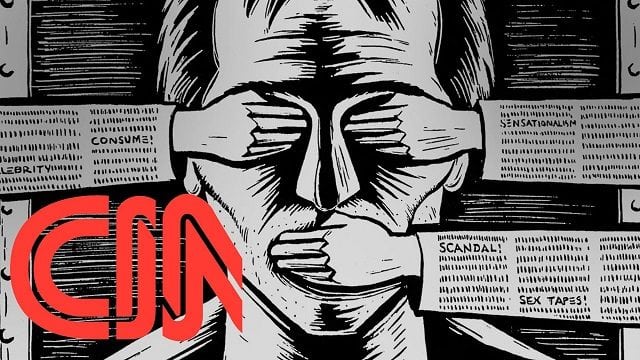
According to Alex Constantine (Mockingbird: The Subversion Of The Free Press By The CIA), in the 1950s, “some 3,000 salaried and contract CIA employees were eventually engaged in propaganda efforts”. Wisner was also able to restrict newspapers from reporting about certain events. For example, the CIA plots to overthrow the governments of Iran and Guatemala.
Thomas Braden, head of the of International Organizations Division (IOD), played an important role in Operation Mockingbird. Many years later he revealed his role in these events: “If the director of CIA wanted to extend a present, say, to someone in Europe - a Labour leader - suppose he just thought, This man can use fifty thousand dollars, he’s working well and doing a good job - he could hand it to him and never have to account to anybody… There was simply no limit to the money it could spend and no limit to the people it could hire and no limit to the activities it could decide were necessary to conduct the war - the secret war…. It was a multinational. Maybe it was one of the first. Journalists were a target, labor unions a particular target - that was one of the activities in which the communists spent the most money.”
In August, 1952, the Office of Policy Coordination and the Office of Special Operations (the espionage division) were merged to form the Directorate of Plans (DPP). Frank Wisner became head of this new organization and Richard Helms became his chief of operations. Mockingbird was now the responsibility of the DPP.
J. Edgar Hoover became jealous of the CIA’s growing power. He described the OPC as “Wisner’s gang of weirdos” and began carrying out investigations into their past. It did not take him long to discover that some of them had been active in left-wing politics in the 1930s. This information was passed to who started making attacks on members of the OPC. Hoover also gave McCarthy details of an affair that Frank Wisner had with Princess Caradja in Romania during the war. Hoover, claimed that Caradja was a Soviet agent.
Joseph McCarthy also began accusing other senior members of the CIA as being security risks. McCarthy claimed that the CIA was a “sinkhole of communists” and claimed he intended to root out a hundred of them. One of his first targets was Cord Meyer, who was still working for Operation Mockingbird. In August, 1953, Richard Helms, Wisner’s deputy at the OPC, told Meyer that Joseph McCarthy had accused him of being a communist. The Federal Bureau of Investigation added to the smear by announcing it was unwilling to give Meyer “security clearance”. However, the FBI refused to explain what evidence they had against Meyer. Allen W. Dulles and both came to his defence and refused to permit a FBI interrogation of Meyer.
Joseph McCarthy did not realise what he was taking on. Wisner unleashed Mockingbird on McCarthy. Drew Pearson, Joe Alsop, Jack Anderson, Walter Lippmann and Ed Murrow all went into attack mode and McCarthy was permanently damaged by the press coverage orchestrated by Wisner.
Mockingbird was very active during the overthrow of Jacobo Arbenz in Guatemala. People like Henry Luce was able to censor stories that appeared too sympathetic towards the plight of Arbenz. Allen W. Dulles was even able to keep left-wing journalists from travelling to Guatemala. This including Sydney Gruson of the New York Times.
Frank Wisner was also interested in influencing Hollywood. As Hugh Wilford points out in The Mighty Wurlitzer: How the CIA Played America (2008): “Fortunately for the CIA, two factors predisposed the major Hollywood studios that dominated the industry to take a responsible position in the cultural Cold War. One was a strong tendency toward self-censorship, the result of many years’ experience avoiding the commercially disastrous effects of giving offense to either domestic pressure groups like the American Legion or foreign audiences. The other was the fact that the men who ran the studios were intensely patriotic and anticommunist - they saw it as their duty to help their government defeat the Soviet threat.“
Frank Wisner was helped by the fact that the House of Un-American Activities Committee (HUAC), chaired by J. Parnell Thomas, was carrying out an investigation into the Hollywood Motion Picture Industry. The HUAC interviewed 41 people who were working in Hollywood. These people attended voluntarily and became known as "friendly witnesses”. During their interviews they named nineteen people who they accused of holding left-wing views.
One of those named, Bertolt Brecht, a playwright, gave evidence and then left for East Germany. Ten others: Herbert Biberman, Lester Cole, Albert Maltz, Adrian Scott, Samuel Ornitz, Dalton Trumbo, Edward Dmytryk, Ring Lardner Jr., John Howard Lawson and Alvah Bessie refused to answer any questions and were sent to prison and were blacklisted from the industry.
The CIA and FBI also provided right-wing television producer, Vincent Harnett, with information about left-wing figures in the industry. In June 1950 Harnett published Red Channels, a pamphlet listing the names of 151 writers, directors and performers who they claimed had been members of subversive organisations before the Second World War but had not so far been blacklisted.
Lee J. Cobb was one of those actors who was originally blacklisted but eventually cooperated with the HUAC: “When the facilities of the government of the United States are drawn on an individual it can be terrifying. The blacklist is just the opening gambit - being deprived of work. Your passport is confiscated. That’s minor. But not being able to move without being tailed is something else. After a certain point it grows to implied as well as articulated threats, and people succumb. My wife did, and she was institutionalized. In 1953 the HCUA did a deal with me. I was pretty much worn down. I had no money. I couldn’t borrow. I had the expenses of taking care of the children. Why am I subjecting my loved ones to this? If it’s worth dying for, and I am just as idealistic as the next fellow. But I decided it wasn’t worth dying for, and if this gesture was the way of getting out of the penitentiary I’d do it. I had to be employable again.”
According to Frances Stonor Saunders, the author of Who Paid the Piper? (2000), Frank Wisner recruited several important figures for Operation Mockingbird. This included former OSS filmmaker John Ford and studio bosses Cecil B. DeMille (Paramount Pictures) and Darryl Zanuck (Twentieth Century-Fox).
Another important figure in this group was Howard Hughes, the boss of RKO Pictures. As Charles Higham points out in Howard Hughes: The Secret Life (2004), this was also good for business: “Hughes’s crusade against Communism” was “exacerbated by his desire to have Hughes Aircraft profit from the Korean and any future anti-Soviet wars”. For example, in June 1950, General Ira Eaker “signed an across-the-board agreement giving Hughes a monopoly in interceptors for the U.S. Air Force… despite the fact that it was in breach of the Sherman anti-monopolies act… By the end of 1950, the war had made Hughes even richer than before.”
Another important figure in this conspiracy was C. D. Jackson. He had joined the Office of Strategic Services (OSS) in 1943. The following year he was appointed Deputy Chief at the Psychological Warfare Division at Supreme Headquarters Allied Expeditionary Force (SHAEF). After the war, he became Managing Director of Time-Life International. When it became clear that Dwight D. Eisenhower stood a good chance of becoming president, the CIA arranged for Jackson to join his campaign. This involved Jackson writing speeches for Eisenhower. Jackson was rewarded in February 1953 by being appointed as Special Assistant to the President. This included the role of Eisenhower’s liaison between the CIA and the Pentagon.
According to the Eisenhower Presidential Library files in Abilene, Kansas, Jackson’s "area responsibility was loosely defined as international affairs, cold war planning, and psychological warfare. His main function was the coordination of activities aimed at interpreting world situations to the best advantage of the United States and her allies and exploiting incidents which reflected negatively on the Soviet Union , Communist China and other enemies in the Cold War.”
Jackson was also involved in Operation Mockingbird. This was revealed after the death of C. D. Jackson. On December 15, 1971, Mrs. C.D. Jackson gave her husband’s papers to the Dwight D. Eisenhower Library. This included details that Jackson was in contact with a CIA agent in Hollywood’s Paramount Studios. The agent is not named by Jackson but Frances Stonor Saunders claims in Who Paid the Piper? (2000) that it was Carleton Alsop, a CIA agent employed by Frank Wisner. There is no doubt that Alsop was one of the CIA agents working at Paramount. However, Hugh Wilford argues in The Mighty Wurlitzer: How the CIA Played America (2008) that it was a senior executive at Paramount, Lugi G. Laraschi, was the most important CIA figure at the studio. Laraschi was the head of foreign and domestic censorship at the studio, whose job was to “iron out any political, moral or religious problems”. Other studios, including MGM and RKO, had similar officers, and were probably CIA placements. In a private letter to Sherman Adams, Jackson claims the role of these CIA placements was “to insert in their scripts and in their action the right ideas with the proper subtlety”.
Although the main objective of Operation Mockingbird was to influence the production of commercial films the CIA also occasionally initiated film projects. The best documented instance of this concerns an animated version of Animal Farm, a satirical allegory about Stalinism by George Orwell. The book was highly popular when it was published in 1945 and it was only natural that the studios should be interested in making a film of the book. The problem for the CIA was that Orwell was a socialist whose book attacked both communism and capitalism. Therefore, it was important to make a film that restricted it to a condemnation of Joseph Stalin and the Soviet Union.
In 1950 Wisner’s OPC arranged for Joe Bryan to recruit anti-communist documentary-maker Louis de Rochemont to produce a movie version of the tale. It was decided to get the film made in Britain to disguise CIA involvement in the project. Rochemont employed the British animation studio of husband and wife John Halas and Joy Batchelor to make the film. Most of the funding came from a CIA shell corporation, Touchstone. E. Howard Hunt was one of those agents involved in the production of the film whose role was to remove the socialist elements in Orwell’s allegory.
One unnamed member of the OPC sent a letter to John Halas called for the addition of scenes showing the other farms (that represented capitalist countries) in a more flattering light. The most important demand was to change the ending of Animal Farm. The CIA did not like the scene where the pigs and dogs face a liberation-style uprising of the other animals. The letter included the following: “It is reasonable to expect that if Orwell were to write the book today, it would be considerably different and that the changes would tend to make it even more positively anti-Communist and possibly somewhat more favorable to the Western powers.”
One of the main concerns of the CIA was the portrayal of race-relations in Hollywood movies. It was argued that the left was using this issue to undermine the idea that America was a democracy based on equal rights. Letters from Jackson sent to the producers of films called for scenes showing African Americans mixing on equal terms with whites. One of Jackson’s proposals involved “planting black spectators in a crowd watching a golf game in the Martin and Lewis comedy The Caddy”.
In 1955 Graham Greene published The Quiet American. The novel is set in Vietnam and involves the relationship between Thomas Fowler and Alden Pyle. Fowler is a veteran British journalist in his fifties, who has been covering the war in Vietnam for over two years. Pyle, the “Quiet American” of the title, is officially an aid worker, but is really employed by the CIA. It is believed that the Pyle character is partly based on that of Edward Lansdale.
Greene had worked for the British Secret Service during the Second World War. Although a fairly successful novelist at the time, Greene was also employed by The Times and Le Figaro as a journalist. Between 1951 to 1954 spent a long period of time in Saigon. In 1953 Lansdale became a CIA advisor on special counter-guerrilla operations to French forces against the Viet Minh.
While it is true that Graham Greene admitted that he never had the “misfortune to meet” Lansdale, the two men did know a lot about each other. Lansdale recalls that in 1954 he had dinner with Peg and Tilman Durdin at the Continental Hotel in Saigon. Greene was also there having a meal with several French officers. Lansdale claims that after he and the Durdins were leaving, Greene said something in French to his companions and the men began booing him.
Lansdale definitely thought that Pyle was based on him. He told Cecil B. Currey on 15th February, 1984: “Pyle was close to Trinh Minh Thé, the guerrilla leader, and also had a dog that went with him everywhere - and I was the only American close to Trinh Minh Thé and my poodle Pierre went everything with me.”
In the book Pyle is sent to Vietnam by his government, ostensibly as a member of the American Economic Mission, but that assignment was only a cover for his real role as a CIA agent. According to one critic “Pyle was the embodiment of well-meaning American-style politics, and he blundered through the intrigue, treachery, and confusion of Vietnamese politics, leaving a trail of blood and suffering behind him.” As Fowler points out in the novel, Pyle was attempting to “win the East for Democracy”. However, according to Fowler, what the people of Vietnam really wanted was “enough rice” to eat. What is more: “They don’t want to be shot at. They want one day to be much the same as another. They don’t want our white skins around telling them what they want.”
When the book was published in the United States in 1956 it was condemned as anti-American. Pyle (Lansdale) is portrayed as someone whose belief in the justice of American foreign policy allows him to ignore the appalling consequences of his actions. It was criticized by The New Yorker for portraying Americans as murderers.
The director, producer and screenwriter, Joseph L. Mankiewicz was chosen to make the film of The Quiet American. He visited Saigon in 1956 and was introduced to Edward Lansdale, whose cover was working at the International Rescue Committee’s office. The most controversial scene in the book is the bombing of a Saigon square in 1952 by a Vietnamese associate of Lansdale’s, General Trinh Minh Thé. In the novel, Greene suggests that Pyle/Lansdale, was behind the bombing. Lansdale suggested to Mankiewicz that the film should show that the bombing was “actually having been a Communist action”.
When he returned home Mankiewicz wrote to John O’Daniel, the chairman of the American Friends of Vietnam that he intended to completely change the anti-American attitude of Greene’s book. This included the casting of Second World War hero, Audie Murphy, as Alden Pyle.
In a letter that Edward Lansdale wrote to Ngo Dinh Diem he praised Mankiewicz’s treatment of the story as “an excellent change from Mr. Greene’s novel of despair” and “that it will help win more friends for you and Vietnam in many places in the world where it is shown.“
As Hugh Wilford pointed out: “It was a brilliantly devious maneuver of postmodern literary complexity: by helping to rewrite a story featuring a character reputedly based on himself, Lansdale had transformed an anti-American tract into a cinematic apology for U.S. policy - and his own actions-in Vietnam.”
Graham Greene was furious with Mankiewicz’s treatment ofhis novel. "Far was it from my mind, when I wrote The Quiet American that the book would become a source of spiritual profit to one of the most corrupt governments in Southeast Asia.”
In 1955 President Dwight Eisenhower established the 5412 Committee in order to keep a check on the CIA’s covert activities. The committee (also called the Special Group) included the CIA director, the national security adviser, and the deputy secretaries at State and Defence and had the responsibility to decide whether covert actions were “proper” and in the national interest. It was also decided to include Richard B. Russell, chairman of the Senate Armed Services Committee. However, as Allen W. Dulles was later to admit, because of “plausible deniability” planned covert actions were not referred to the 5412 Committee.

Anderson Cooper and Yale university recruitment ground.
Dwight Eisenhower became concerned about CIA covert activities and in 1956 appointed David Bruce as a member of the President’s Board of Consultants on Foreign Intelligence Activities (PBCFIA). Eisenhower asked Bruce to write a report on the CIA. It was presented to Eisenhower on 20th December, 1956. Bruce argued that the CIA’s covert actions were “responsible in great measure for stirring up the turmoil and raising the doubts about us that exists in many countries in the world today.” Bruce was also highly critical of Mockingbird. He argued: “what right have we to go barging around in other countries buying newspapers and handling money to opposition parties or supporting a candidate for this, that, or the other office.”
After Richard Bissell lost his post as Director of Plans in 1962, Tracy Barnes took over the running of Mockingbird. According to Evan Thomas (The Very Best Men) Barnes planted editorials about political candidates who were regarded as pro-CIA.
In 1963, John McCone, the director of the CIA, discovered that Random House intended to publish Invisible Government by David Wise and Thomas Ross. McCone discovered that the book intended to look at his links with the Military Industrial Congress Complex. The authors also claimed that the CIA was having a major influence on American foreign policy. This included the overthrow of Mohammed Mossadegh in Iran (1953) and Jacobo Arbenz in Guatemala (1954). The book also covered the role that the CIA played in the Bay of Pigs operation, the attempts to remove President Sukarno in Indonesia and the covert operations taking place in Laos and Vietnam.
John McCone called in Wise and Ross to demand deletions on the basis of galleys the CIA had secretly obtained from Random House. The authors refused to made these changes and Random House decided to go ahead and publish the book. The CIA considered buying up the entire printing of Invisible Government but this idea was rejected when Random House pointed out that if this happened they would have to print a second edition. McCone now formed a special group to deal with the book and tried to arrange for it to get bad reviews.

Invisible Government was published in 1964. It was the first full account of America’s intelligence and espionage apparatus. In the book Wise and Ross argued that the “Invisible Government is made up of many agencies and people, including the intelligence branches of the State and Defense Departments, of the Army, Navy and Air Force”. However, they claimed that the most important organization involved in this process was the CIA.
John McCone also attempted to stop Edward Yates from making a documentary on the CIA for the National Broadcasting Company (NBC). This attempt at censorship failed and NBC went ahead and broadcast this critical documentary.
In June, 1965, Desmond FitzGerald was appointed as head of the Directorate for Plans. He now took charge of Mockingbird. At the end of 1966 FitzGerald discovered that Ramparts, a left-wing publication, was planning to publish that the CIA had been secretly funding the National Student Association. FitzGerald ordered Edgar Applewhite to organize a campaign against the magazine. Applewhite later told Evan Thomas for his book, The Very Best Men: “I had all sorts of dirty tricks to hurt their circulation and financing. The people running Ramparts were vulnerable to blackmail. We had awful things in mind, some of which we carried off.”
This dirty tricks campaign failed to stop Ramparts publishing this story in March, 1967. The article, written by Sol Stern, was entitled NSA and the CIA. As well as reporting CIA funding of the National Student Association it exposed the whole system of anti-Communist front organizations in Europe, Asia, and South America. It named Cord Meyer as a key figure in this campaign. This included the funding of the literary journal Encounter.
In May 1967 Thomas Braden responded to this by publishing an article entitled, I’m Glad the CIA is Immoral, in the Saturday Evening Post, where he defended the activities of the International Organizations Division unit of the CIA. Braden also confessed that the activities of the CIA had to be kept secret from Congress. As he pointed out in the article: “In the early 1950s, when the cold war was really hot, the idea that Congress would have approved many of our projects was about as likely as the John Birch Society’s approving Medicare.”
Meyer’s role in Operation Mockingbird was further exposed in 1972 when he was accused of interfering with the publication of a book, The Politics of Heroin in Southeast Asia by Alfred W. McCoy. The book was highly critical of the CIA’s dealings with the drug traffic in Southeast Asia. The publisher, who leaked the story, had been a former colleague of Meyer’s when he was a liberal activist after the war.
Further details of Operation Mockingbird was revealed as a result of the Frank Church investigations (Select Committee to Study Governmental Operations with Respect to Intelligence Activities) in 1975. According to the Congress report published in 1976: “The CIA currently maintains a network of several hundred foreign individuals around the world who provide intelligence for the CIA and at times attempt to influence opinion through the use of covert propaganda. These individuals provide the CIA with direct access to a large number of newspapers and periodicals, scores of press services and news agencies, radio and television stations, commercial book publishers, and other foreign media outlets.” Church argued that the cost of misinforming the world cost American taxpayers an estimated $265 million a year.
Frank Church showed that it was CIA policy to use clandestine handling of journalists and authors to get information published initially in the foreign media in order to get it disseminated in the United States. Church quotes from one document written by the Chief of the Covert Action Staff on how this process worked (page 193). For example, he writes: “Get books published or distributed abroad without revealing any U.S. influence, by covertly subsidizing foreign publicans or booksellers.” Later in the document he writes: “Get books published for operational reasons, regardless of commercial viability”. Church goes onto report that “over a thousand books were produced, subsidized or sponsored by the CIA before the end of 1967”. All these books eventually found their way into the American market-place. Either in their original form (Church gives the example of the Penkovskiy Papers) or repackaged as articles for American newspapers and magazines.
In another document published in 1961 the Chief of the Agency’s propaganda unit wrote: “The advantage of our direct contact with the author is that we can acquaint him in great detail with our intentions; that we can provide him with whatever material we want him to include and that we can check the manuscript at every stage… (the Agency) must make sure the actual manuscript will correspond with our operational and propagandistic intention.”
Church quotes Thomas H. Karamessines as saying: “If you plant an article in some paper overseas, and it is a hard-hitting article, or a revelation, there is no way of guaranteeing that it is not going to be picked up and published by the Associated Press in this country” (page 198).
By analyzing CIA documents Church was able to identify over 50 U.S. journalists who were employed directly by the Agency. He was aware that there were a lot more who enjoyed a very close relationship with the CIA who were “being paid regularly for their services, to those who receive only occasional gifts and reimbursements from the CIA” (page 195).
Church pointed out that this was probably only the tip of the iceberg because the CIA refused to “provide the names of its media agents or the names of media organizations with which they are connected” (page 195). Church was also aware that most of these payments were not documented. This was the main point of the Otis Pike Report. If these payments were not documented and accounted for, there must be a strong possibility of financial corruption taking place. This includes the large commercial contracts that the CIA was responsible for distributing. Pike’s report actually highlighted in 1976 what eventually emerged in the 1980s via the activities of CIA operatives such as Edwin Wilson, Thomas Clines, Ted Shackley, Raphael Quintero, Richard Secord and Felix Rodriguez.
Church also identified E. Howard Hunt as an important figure in Operation Mockingbird. He points out how Hunt arranged for books to be reviewed by certain writers in the national press. He gives the example of how Hunt arranged for a “CIA writer under contract” to write a hostile review of a Edgar Snow book in the New York Times (page 198).
Church comes up with this conclusion to his examination of this issue: “In examining the CIA’s past and present use of the U.S. media, the Committee finds two reasons for concern. The first is the potential, inherent in covert media operations, for manipulating or incidentally misleading the American public. The second is the damage to the credibility and independence of a free press which may be caused by covert relationships with the U.S. journalists and media organizations.”
In February, 1976, George Bush, the recently appointed Director of the CIA announced a new policy: “Effective immediately, the CIA will not enter into any paid or contract relationship with any full-time or part-time news correspondent accredited by any U.S. news service, newspaper, periodical, radio or television network or station.” However, he added that the CIA would continue to “welcome” the voluntary, unpaid cooperation of journalists.
Carl Bernstein, who had worked with Bob Woodward in the investigation of Watergate, provided further information about Operation Mockingbird in an article in The Rolling Stone in October, 1977. Bernstein claimed that over a 25 year period over 400 American journalists secretly carried out assignments for the CIA: “Some of the journalists were Pulitzer Prize winners, distinguished reporters who considered themselves ambassadors-without-portfolio for their country. Most were less exalted: foreign correspondents who found that their association with the Agency helped their work; stringers and freelancers who were as interested it the derring-do of the spy business as in filing articles, and, the smallest category, full-time CIA employees masquerading as journalists abroad.”
It is almost certain that Bernstein had encountered Operation Mockingbird while working on his Watergate investigation. For example, Deborah Davis (Katharine the Great) has argued that Deep Throat was senior CIA official, Richard Ober, who was running Operation Chaos for Richard Nixon during this period.
According to researchers such as Steve Kangas, Angus Mackenzie and Alex Constantine, Operation Mockingbird was not closed down by the CIA in 1976. For example, in 1998 Kangas argued that CIA asset Richard Mellon Scaife ran “Forum World Features, a foreign news service used as a front to disseminate CIA propaganda around the world.”
On 8th February, 1999, Kangas was found dead in the bathroom of the Pittsburgh offices of Richard Mellon Scaife. He had been shot in the head. Officially he had committed suicide but some people believe he was murdered. In an article in Salon Magazine, (19th March, 1999) Andrew Leonard asked: “Why did the police report say the gun wound was to the left of his head, while the autopsy reported a wound on the roof of his mouth? Why had the hard drive on his computer been erased shortly after his death? Why had Scaife assigned his No. 1 private detective, Rex Armistead, to look into Kangas’ past?
by Spartacus Schoolnet